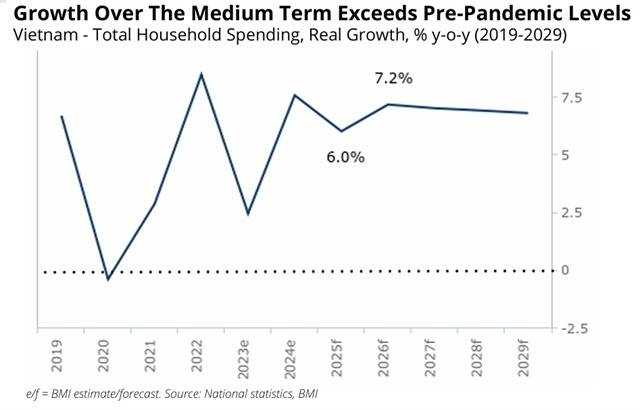Positive outlook for consumer spending in Việt Nam through 2025–26: BMI
Positive outlook for consumer spending in Việt Nam through 2025–26: BMI
Consumer spending in Việt Nam is set to grow strongly over the next two years, driven by solid economic growth, rising incomes, and a stable labour market, according to BMI.

Installment loans are widely offered in Việt Nam for everyday consumer purchases. — Photo hanoimoi.vn |
Consumer spending in Việt Nam is expected to grow strongly over the next two years, supported by robust economic growth, higher disposable incomes and a solid labour market, according to the latest forecast from BMI, a Fitch Solutions company.
In 2025, household spending is projected to grow by 6.0 per cent in real terms, reaching nearly VNĐ3.6 quadrillion (US$138.5 billion), significantly higher than the pre-Covid level of VNĐ2.77 quadrillion in 2019.
By 2026, growth will accelerate further to 7.2 per cent, reaching VNĐ3.85 quadrillion.
Stable inflation and a tightening labour market are helping to increase real wages, improving the purchasing power of Vietnamese households.
Retail sales in June 2025 rose by 8.3 per cent year-on-year, showing the resilience of domestic consumption despite global challenges. Although it was the slowest growth since October 2024, retail sales remain strong by regional standards. To boost domestic demand, the Government plans tax incentives and trade promotion programmes.
Việt Nam’s economy is expected to stay supportive, with GDP target of at least 8 per cent in 2025 and double digits in the following years. Inflation should hold at 3.5 per cent, and unemployment at a low 2.1 per cent, supporting wage growth and household spending.

Installment loans are widely offered in Việt Nam for everyday consumer purchases. — Photo hanoimoi.vn |
The Vietnamese đồng is also expected to strengthen slightly against the US dollar, making imported goods cheaper and supporting consumer demand.
However, risks remain.
High household debt remains a concern, potentially limiting future borrowing and disposable income.
Figures provided by the State Bank of Vietnam indicate that consumer lending in Việt Nam has grown tenfold over the past decade. By end-2022, consumer credit reached $150 billion, or 40 per cent of GDP, much of it tied to housing and small consumer goods. While lower interest rates in 2025 may ease repayment burdens, global rate shifts or a credit slowdown could still affect spending.
Additionally, global risks like trade tensions, supply issues and weaker demand may impact Việt Nam’s exports and household spending. A major economy downturn could further dent consumer confidence.
Despite these risks, BMI remains confident in Việt Nam’s consumer spending potential. Real earnings are forecast to grow by an average of 4.8 per cent through to 2029, pushing purchasing power up by 13 per cent compared to 2019.
With a young, dynamic population and rising incomes, Việt Nam’s retail and consumer markets are set to remain among the fastest growing in the region.
- 12:47 31/07/2025























